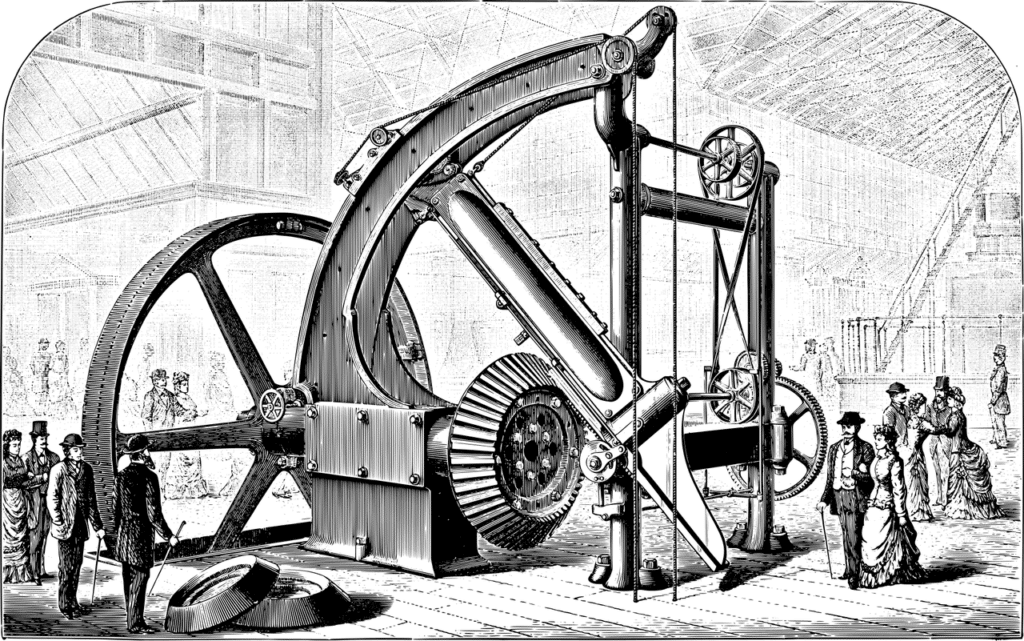Definition of the industrial revolution: A period of transformative economic development in the UK, powered by new technologies, fossil fuel energy and changes to the workforce.
What is the industrial revolution?
The industrial revolution is the period of rapid economic progress which took place mainly in the 18th and 19th centuries. It began in England, but also took root in other countries such as the United States.
Before the industrial revolution, most industries were small scale ‘cottage’ industries, where workers banded together in small teams or worked alone – to produce their output.

- By the end of the industrial revolution, large corporations controlled a workforce of millions of workers.
- Entrepreneurs had amassed wealth equivalent to billions of dollars in today’s money.
- The quality of life of a once peasant farmer workforce had begun to improve.
Countries which began on the industrialisation path earlier were then able to generate considerable wealth by exporting a high volume of high-quality products abroad. Economics books will be able to provide a rich history of these periods.
The industrial revolution occurred as a result of these factors:
Energy use
People began to harness energy sources to improve the productivity of their processes. Cotton and flour mills were built by rivers, and use a waterwheel to power their machinery.
Later, coal was used to fuel steam engines which produced significantly more power on demand.
New materials
Steel was invented in 1850, which provided engineers with a light-weight material capable of withstanding huge pressures. Steel and other alloys made machines like steam locomotives, and the tracks they ran on physically possible.
Mass-production
During the industrial revolution, workers were organised into large mills or factories which could house hundreds of workers. Under the strict oversight of layers of management, these factories were more efficient than small workshops due to economies of scale and specialisation.
Ample supply of workers
The steady improvements in farming efficiency meant that farm labourer pay was low and employment opportunities were dwindling. This provided a push factor which encouraged whole communities of farmer workers to move to cities in pursuit of new opportunities.
This provided large factories, mills and warehouses with a steady supply of new labour to keep their expanding operations fully staffed.
Limited employment rights
The working conditions of employees during the industrial revolution were almost universally terrible.
Working hours were long. Employees could be expected to work for 14 – 16 hours a day, for 6 days each week.
Children were also lured into the workforce – cotton mills would place them in great peril by using them to crawl into tight spaces to fix machines or solve tangles.
Employment regulations were virtually non-existent, which enabled the workforce to be worked to the bone in this way.
The Combination Act, which was an English law passed in parliament actually prohibited workers from collectively bargaining in groups for better terms and working conditions.
This naturally meant that the economic productivity of mills was higher than it would have been otherwise.
Engineering advancements
Scientists and engineers made a breakthrough after breakthrough during the industrial revolution.
One invention or technique would then enable another, and so on, perpetuating an acceleration in technology which has continued ever since until this day.
Here is a brief timeline of some of the key inventions which paved the way for the expanse of the textile industry in the UK:
1733 – The Flying Shuttle (John Kay) automated the process of weaving cotton into a piece of fabric. This had previously been woven by hand with the use of a small spinning wheel.
1764 – The Spinning Jenny (James Hargreaves) increased the volume of fabric which a single machine could produce.
1769 – The Water Frame (Richard Arkwright) which allowed spinning machines to be connected to water power.
1769 – Steam engine efficiency upgrades (James Watt) made the steam engine viable for use in industrial settings in the future.
1816 – The steam engine locomotive (George Stephenson) which paves the way for coal, goods (and later) passengers to be transported by rail.
How does the definition of industrial revolution relate to investing?
Investing books will explain that the industrial revolution was the period in which the stock markets and bond markets began to resemble the massive pools of capital which they are today.
Projects vastly increased in size, and therefore they required lots of financing.
The stock and bond markets helped to connect the wealth of the landed gentry to the entrepreneurial spirit of the middle classes and engineers to enable them to invest in property, equipment and a workforce to begin production.
Given the scale of ambition and the risk taken on by investors, it may not surprise you to learn that bankruptcy rules were also established in the same era.